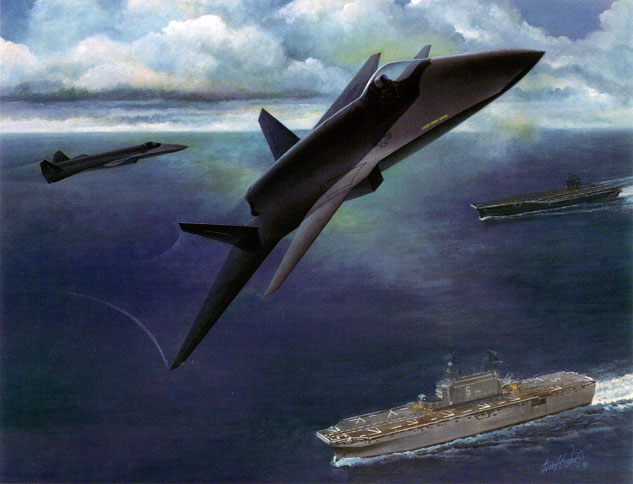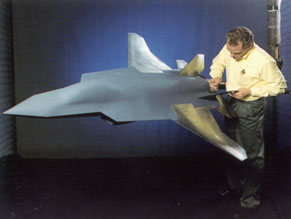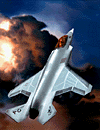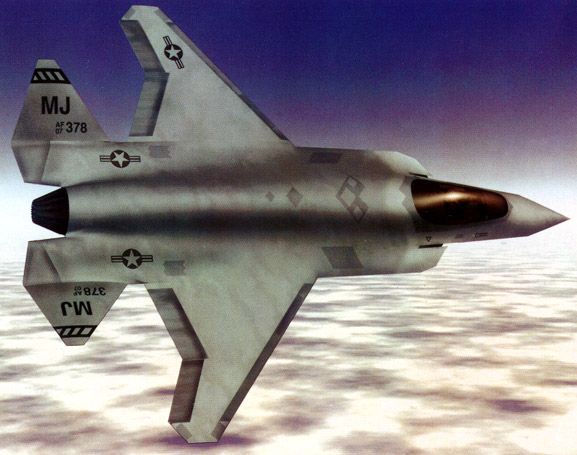


Aircraft of the Month for May 2000

McDonnell Douglas JSF
by Alex Stoll





In September 1993 the USAF's MRF, a planned F-16 replacement, and the A/F-X, a joint-service dual-role swing-wing deep strike fighter, were canceled. A new program, JAST (Joint Advanced Strike Technology), was established, to develop technology for a new fighter. BAe and Northrop Grumman joined MD in 1994. This created a team with a vast amount of relevant expreience: MD and BAe had produced the Harrier, and were well acquanited with STOVL (neither Boeing or Lockheed had produced any operational STOVL aircraft); MD and Grumman had a lot of experience with carrier fighters (far more than Boeing and Lockheed combined); Northrop had a lot of stealth experience (with the B-2 and YF-23); and Grumman had a lot of experience in all-weather strike systems.

 By mid 1995, however, MD was running into trouble: in June, just a year before the planned down-select date, MD redesigned their entry. The redesign had no canards and no vertical tails - just a "lambda" wing, reminiscent of the F-101 or B-2, and horizontal tails that slanted up, reminiscent of the YF-23. Control was augmented by split outboard brake/rudder/aileron surfaces similar to the B-2's and a pitch and yaw vectoring nozzle. After all, said John W. Steuer, the company program manager, "Birds don't have vertical tails." The wing control surfaces, folding outer wings, and tail surfaces were larger on the Navy version, like the Lockheed Martin entry, providing additional wing area while keeping the basic structure common. The redesign was influenced by the X-36, an experimental small-scale RPV with canards, wings, no tails, a yaw-only vectoring engine, and split brake/rudder/elevons. But they also changed their design to use Northrop Grumman's original lift-plus-lift/cruise (LPLC) scheme, and the almost completed large-scale powered model of the gas-driven lift-fan design had to be abandoned. MD had deemed LPLC to be the lightest solution, and the one that afforded the most commonaltiy with CTOL versions (because of the large hot-gas ducts in the mid-fuselage requred for the gas-driven system). Retractable vectoring nozzles under the fuselage were used for takeoff and landing. But the LPLC configuration had big disadvantages, mainly that all the engines needed to work for the aircraft to make a short or vertical landing. The redesign did have some advantages: it was sleeker, it had less drag than a conventional design, and it looked more stealthy. MD did not show its definitive design in early 1996, unlike Boeing and Lockheed Martin (LM). MD, Boeing, and LM were chosen over Rockwell as candidates for the JAST program that year. A request for proposal was issued by the JAST program office in March 1996 with a deadline in June, and the name changed to Joint Strike Fighter (JSF).
By mid 1995, however, MD was running into trouble: in June, just a year before the planned down-select date, MD redesigned their entry. The redesign had no canards and no vertical tails - just a "lambda" wing, reminiscent of the F-101 or B-2, and horizontal tails that slanted up, reminiscent of the YF-23. Control was augmented by split outboard brake/rudder/aileron surfaces similar to the B-2's and a pitch and yaw vectoring nozzle. After all, said John W. Steuer, the company program manager, "Birds don't have vertical tails." The wing control surfaces, folding outer wings, and tail surfaces were larger on the Navy version, like the Lockheed Martin entry, providing additional wing area while keeping the basic structure common. The redesign was influenced by the X-36, an experimental small-scale RPV with canards, wings, no tails, a yaw-only vectoring engine, and split brake/rudder/elevons. But they also changed their design to use Northrop Grumman's original lift-plus-lift/cruise (LPLC) scheme, and the almost completed large-scale powered model of the gas-driven lift-fan design had to be abandoned. MD had deemed LPLC to be the lightest solution, and the one that afforded the most commonaltiy with CTOL versions (because of the large hot-gas ducts in the mid-fuselage requred for the gas-driven system). Retractable vectoring nozzles under the fuselage were used for takeoff and landing. But the LPLC configuration had big disadvantages, mainly that all the engines needed to work for the aircraft to make a short or vertical landing. The redesign did have some advantages: it was sleeker, it had less drag than a conventional design, and it looked more stealthy. MD did not show its definitive design in early 1996, unlike Boeing and Lockheed Martin (LM). MD, Boeing, and LM were chosen over Rockwell as candidates for the JAST program that year. A request for proposal was issued by the JAST program office in March 1996 with a deadline in June, and the name changed to Joint Strike Fighter (JSF).

MD was confident that they would not lose the JSF contract, but the military had a habit of picking aircraft that were different from each other for flyoffs. They also liked to pick a low-risk and a high-risk aircraft. This pattern was followed in the LWF (YF-16 and YF-17), Advanced Medium STOL Transport (YC-14 and YC-15), and ATF (YF-22 and YF-23) projects. They ended up also following this pattern for the JSF program: on 16 November 1996, the Boeing design was picked as a high-risk design, and LM was picked, mainly because they had already done testing and their JSF was based on the proven F-22 (low-risk). MD was hit hard, because their commercial aircraft business was in a bad decline (they began backing out of the commericial aircraft market in October 1996, becoming a niche player) and their military market was headed down in the long term. Initally MD believed they were not doomed, mainly because C-17s and about 1,000 F/A-18 versions were planned to be bought in the next 15 years. Also, orders were still coming in for the F-15 and MD was stepping up production. "People have counted us out before in past decisions like the JSF, but we have always bounced back," President Harry C. Stonecipher wrote. On 20 January 1997 MD signed a deal with Boeing to work on the Boeing JSF, but not long after that MD merged into Boeing.
| Other Images |